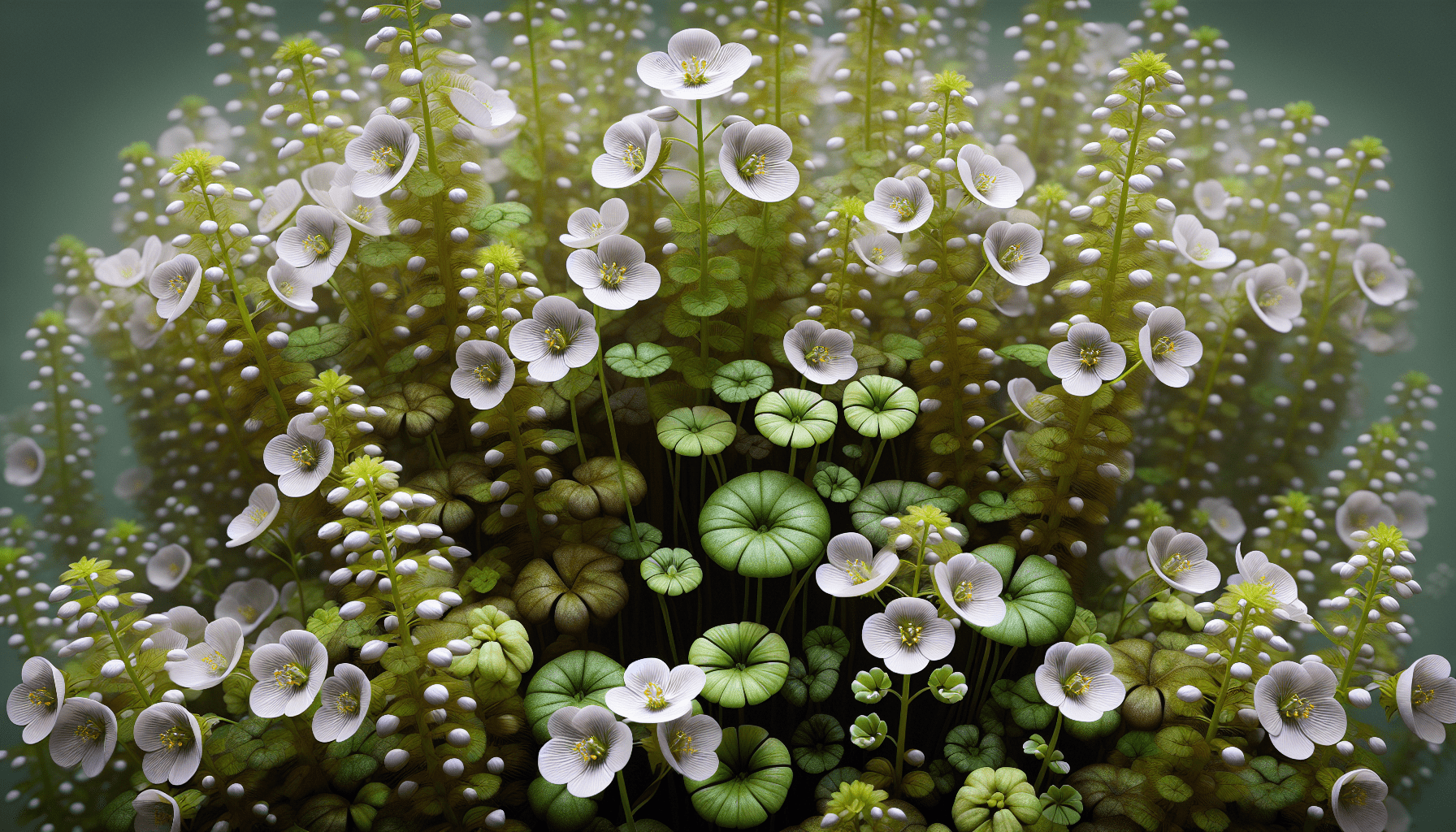As a keen researcher, you appreciate articles that expand your knowledge on topics in the sphere of botany. Let’s explore the subject at hand; the aquatic weed known as Bacopa Rotundifolia. Known for thriving in moist environments, the Bacopa Rotundifolia is a perennial herb whose influence extends beyond its ecological realm due to its medicinal properties. In this article, you will learn about the unique biological characteristics of this aquatic plant, its habitat, and its value to both ecosystems at large and the world of medicine. So as to provide a comprehensive understanding, the text will also cover the challenges associated with controlling the expansion of this species in habitats where it is considered invasive. Drawing from expert sources and recent studies, this article aims to offer you an in-depth understanding of Bacopa Rotundifolia.

Scientific Classification of Bacopa Rotundifolia
In the scientific world, each organism is given a unique name and a comprehensive classification under a universal system called the binomial nomenclature. This classification includes various taxa such as kingdom, domain, phylum, class, order, family, genus, and species, each of which provides detailed information regarding the organism’s phylogeny and taxonomy.
Kingdom and Domain
Bacopa Rotundifolia falls under the Kingdom Plantae, indicating that it is a multicellular eukaryote which performs photosynthesis. Simultaneously, this plant belongs to the Domain Eukarya, comprising organisms that possess a true nucleus and membrane-bound organelles.
Phylum and Class
This aquatic plant belongs to the Phylum Tracheophyta, that includes plants with well-developed vascular systems, and the Class Magnoliopsida, indicating that it is a flowering plant or angiosperm.
Order and Family
Within the system, Bacopa Rotundifolia is classified under the Order Lamiales and the Family Plantaginaceae, an order and family that generally includes many herbaceous plants and shrubs.
Genus and Species
Finally, Bacopa Rotundifolia falls under the Genus Bacopa, which is a group of perennial aquatic plants native to many parts of the world, and the species is identified as Rotundifolia.
Chemical Description of Bacopa Rotundifolia
To fully appreciate the significance of Bacopa Rotundifolia, understanding its chemical composition is necessary.
List of Compounds Present
The plant is primarily associated with the presence of saponins, sterols, alkaloids, and triterpenoid compounds. These chemical compounds have been identified through various methods of phytochemical screening.
Concentration of Each Compound
The concentration of each compound varies depending on growing conditions. However, research has shown that saponins are generally present in higher concentrations compared to other compounds. Bacopa Rotundifolia’s saponin content is particularly significant, as it may be attributable to many of the plant’s properties.
Habitat and Distribution of Bacopa Rotundifolia
The domain of Bacopa Rotundifolia reaches far and wide, explaining its global relevance.
Native Regions
Natively, Bacopa Rotundifolia is commonly reported in sub-Saharan Africa, South and Central America, and parts of Southern United States.
Introduced Regions
Nonetheless, it was introduced to several other regions worldwide, including parts of Asia, Europe, and Oceania, either intentionally or by unintentional dispersal.
Preferred Habitat Characteristics
Though adaptable, Bacopa Rotundifolia shows a preference for wet, fertile soils along the edges of ponds, streams, and ditches. It is an aquatic plant typically found in shallow, slow-moving bodies of freshwater.
Morphology of Bacopa Rotundifolia
Understanding this plant requires a plunge into the special morphological features that characterize it.
Description of Overall Structure
Bacopa Rotundifolia is a semi-erect or creeping herbaceous plant. Typically, it can achieve an average height of 10-30 cm, though optimal growing conditions can lead the plant to surpass this.
Leaf Characteristics
The leaves of Bacopa Rotundifolia are small, round, fleshy, arranged oppositely, and tend to be light green to yellowish-green in color. The thickness of the leaves helps the plant resist drought conditions.
Stem Characteristics
The plant’s stem is robust, creeping along the ground, often developing roots at nodes in an advantageous adaptation for survival.
Root System Description
The root system is expansive, allowing the plant to tolerate a wide range of soil types and moisture conditions.
Flowers and Fruits Description
Bacopa Rotundifolia flowers are white to slightly purplish, often appearing in pairs that are axillary to the leaves, presenting a pleasing aesthetic view. Fruits are capsules that produce numerous minute, dust-like seeds.

Planting Bacopa Rotundifolia
To maximize Bacopa Rotundifolia usefulness, propagation is fundamental.
Propaganda by Seeds
As the plant produces many tiny seeds, it can be propagated by seed dispersion, typically by water or wind.
Propaganda by Stem Cuttings
Alternatively, the plant can also be propagated through stem cuttings. This involves cutting a stem section, placing it in water or damp soil, and allowing it to root.
Optimal Conditions for Planting
For optimum growth, Bacopa Rotundifolia requires a sunny location with fertile, wet soil. It can endure brief periods of drying but performs best in consistently moist or wet conditions.
Benefits of Bacopa Rotundifolia
While commonly seen as a weed, Bacopa Rotundifolia offers an array of benefits.
Ecological Benefits
Functioning as a ground cover, it prevents soil erosion along water edges and provides habitat and food for a variety of wildlife.
Uses in Traditional Medicine
Historically, Bacopa Rotundifolia was used in traditional medicine for the treatment of various ailments owing to its sterol and alkaloid contents.
Potential Modern Medical Uses
Modern medicine has also begun exploring Bacopa Rotundifolia’s potential, particularly focusing on its saponin content and potential neuroprotective properties.
Threats to Bacopa Rotundifolia
Like any other species, Bacopa Rotundifolia faces several threats.
Environmental Threats
Environmental changes, including alterations in water levels, pollution, and habitat destruction, pose significant threats.
Threats from Other Plant Species
Competition from other plant species, particularly invasive ones, can also threaten its survival.
Threats from Animals
Herbivorous animals that feed on Bacopa Rotundifolia can also be a source of threat.
Control and Management of Bacopa Rotundifolia
While the plant has several benefits, it can also become invasive and disrupt sensitive ecosystems.
Chemical Control Methods
Chemical methods, such as the application of herbicides, are often employed for control.
Biological Control Methods
Biological control, via the introduction of certain insects or fungi that naturally limit the plant’s growth, may also be utilized.
Physical Control Methods
Manual removal or physical barriers can also help manage the plant’s growth.
Current Research on Bacopa Rotundifolia
The plant’s potential medicinal properties have sparked numerous scientific research.
Ongoing Studies
Studies are being conducted on its chemical constituents and potential medical applications.
Recent Breakthroughs
Recent research has indicated potential roles in neuroprotection and cognition enhancement.
Impact of Climate Change on Bacopa Rotundifolia
Climate change threatens to alter the dynamics of Bacopa Rotundifolia’s survival.
Effects of Rising Temperatures
Rising temperatures can change the plant’s life cycle and geographic distribution.
Consequences of Changing Rainfall Patterns
Changing rainfall patterns could significantly affect its habitat and growth.
Predictions for Future Growth Patterns
Nevertheless, given the plant’s adaptability, future growth patterns are complex to predict and will largely depend on how the species accommodates to the changing conditions.
In conclusion, Bacopa Rotundifolia is a significant plant species with potential uses, challenges, and threats. Undoubtedly, further research on this charismatic aquatic plant will unveil even more fascinating aspects about its role in ecology and medicine.